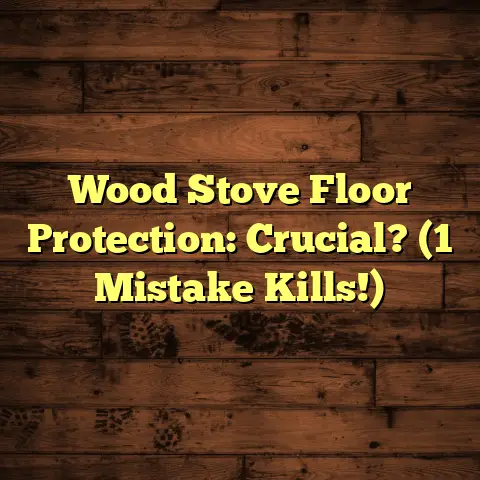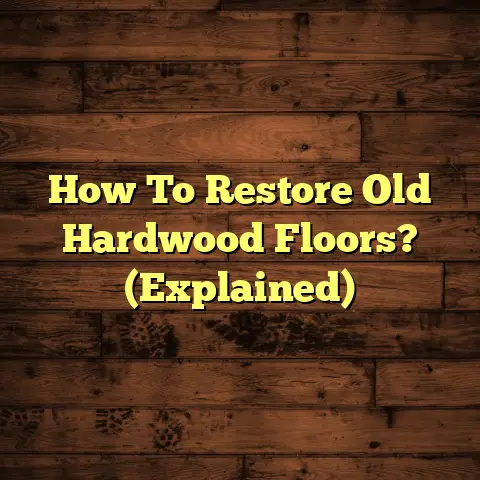Eco-Friendly Flooring Trends? (Top 3 Now!)
Imagine stepping into a sunlit room, where the warmth of natural light dances across the surface of a beautifully crafted floor.
The scent of fresh bamboo fills the air, and your feet glide over the smooth, cool texture of recycled hardwood.
The walls are adorned with potted plants that thrive in the natural environment created by the eco-friendly materials around you.
This space is not just aesthetically pleasing but also a testament to sustainable living, where every choice reflects a commitment to the planet.
In this room, you can feel the harmony between modern design and environmental responsibility, showcasing the latest innovations in eco-friendly flooring.
In my years of experience, I’ve seen firsthand how the demand for sustainable options has skyrocketed.
And honestly, it’s about time!
We all want beautiful homes, but not at the expense of our beautiful planet, right?
So, let’s dive into the top 3 eco-friendly flooring trends that are making waves right now.
I’ll share my insider knowledge, real-world experiences, and maybe even a few trade secrets along the way.
Ready? Let’s get started!
1. Bamboo Flooring: The Sustainable Marvel
Alright, first up is bamboo flooring.
If you’re looking for a sustainable alternative to traditional hardwood, this is it.
Trust me, I’ve installed tons of bamboo floors, and I’m always impressed.
Overview of Bamboo as a Material
Now, you might be thinking, “Bamboo? Isn’t that just for pandas?”
Well, yes, pandas love it, but it’s also an incredible flooring material.
What makes bamboo so special?
It’s all about its rapid growth.
Bamboo is technically a grass, and some species can grow up to 3 feet in just 24 hours!
This means it’s a highly renewable resource, unlike hardwoods that can take decades to mature.
And don’t let its grassy nature fool you – bamboo is surprisingly strong.
In fact, some types of bamboo have a higher tensile strength than steel! (Source: https://www.engineeringtoolbox.com/tensile-strength-d_1455.html)
I’ve seen it hold up beautifully in high-traffic areas, even with kids and pets running around.
Installation and Maintenance
One of the things I love about bamboo flooring is how easy it is to install.
Most bamboo flooring comes in planks that click together, similar to laminate or engineered hardwood.
This makes it a great option for DIYers, but if you’re not comfortable with that, a professional installer (like yours truly!) can get the job done quickly.
Did you know that bamboo can often be installed directly over existing floors?
Yep, that’s right!
As long as your subfloor is level and in good condition, you can save time and money by skipping the demolition step.
Maintenance is a breeze too.
Just sweep or vacuum regularly to remove dirt and debris.
For deeper cleaning, a damp mop with a mild cleaner will do the trick.
I always recommend avoiding harsh chemicals or abrasive cleaners, as they can damage the finish.
Aesthetic Versatility
Okay, let’s talk looks.
Bamboo flooring isn’t just eco-friendly and durable; it’s also gorgeous.
It comes in a variety of finishes and styles to suit any interior design.
You can find bamboo flooring in natural shades, which have a light, airy feel.
Or, you can go for darker, carbonized bamboo, which has a rich, warm tone.
There’s also strand-woven bamboo, which is made by compressing bamboo fibers under high pressure.
This creates a super-dense and durable flooring option with a unique, textured look.
I’ve used it in modern, minimalist spaces and rustic, cozy homes, and it always looks fantastic.
Environmental Impact
Now, let’s get down to the nitty-gritty: the environmental impact.
Choosing bamboo flooring over traditional hardwood can significantly reduce your carbon footprint.
Because bamboo grows so quickly, it replenishes itself much faster than hardwoods.
This means less deforestation and more carbon sequestration.
According to some studies, bamboo forests can absorb more carbon dioxide than hardwood forests. (Source: https://www.bamboou.org/bamboo-facts/)
Plus, bamboo flooring is often manufactured using low-VOC (volatile organic compound) adhesives, which means it won’t release harmful chemicals into your home.
That’s a win-win for your health and the environment!
2. Reclaimed Wood: The Charm of History
Next up, we have reclaimed wood flooring.
This is where sustainability meets character and history.
I’m a huge fan of reclaimed wood because it’s like giving a new life to something old and forgotten.
Definition and Sourcing
So, what exactly is reclaimed wood?
It’s wood that has been salvaged from old buildings, barns, factories, and even shipping pallets.
Instead of ending up in a landfill, this wood is repurposed into beautiful flooring.
I’ve sourced reclaimed wood from all sorts of places.
I remember one project where we used wood from an old textile mill.
You could still see the faint traces of dye on some of the planks, which added so much character!
Finding a reputable supplier is key.
Look for companies that specialize in reclaiming wood and have a good track record of sourcing it responsibly.
Unique Character
One of the best things about reclaimed wood is its unique character.
No two planks are exactly alike.
You’ll find variations in color, grain, and texture that you just can’t get with new wood.
Nail holes, saw marks, and other imperfections tell a story.
They add a sense of history and authenticity to your floors.
I’ve had clients who specifically wanted wood with lots of character, and reclaimed wood never disappoints.
Durability and Longevity
Don’t let its age fool you – reclaimed wood is incredibly durable.
In fact, it’s often more durable than new wood because it has had time to dry and harden over the years.
This means it can withstand years of wear and tear without showing signs of aging.
I’ve seen reclaimed wood floors that are over a century old and still look amazing!
With proper care, a reclaimed wood floor can last for generations.
It’s an investment in your home and a testament to the beauty of sustainable design.
Environmental Benefits
The environmental benefits of using reclaimed wood are huge.
By reusing wood, we’re reducing deforestation and preventing valuable resources from ending up in landfills.
Reclaimed wood also requires less energy to produce than new wood.
There’s no need to cut down trees, transport them to a mill, and process them into lumber.
This significantly reduces the carbon footprint of your flooring.
Did you know that using reclaimed wood can also contribute to LEED (Leadership in Energy and Environmental Design) certification for green building?
LEED is a rating system that recognizes buildings that are designed and constructed in a sustainable way.
3. Cork Flooring: Nature’s Gift
Last but certainly not least, we have cork flooring.
This is a truly unique and sustainable option that often gets overlooked.
I’m here to tell you why it deserves a spot on your radar.
Introduction to Cork as a Flooring Option
Cork is harvested from the bark of cork oak trees, which are primarily found in Portugal and Spain.
The amazing thing about cork harvesting is that it doesn’t harm the tree!
The bark is carefully stripped by hand every nine years, and the tree continues to grow and regenerate.
This makes cork a highly renewable resource.
Cork is also naturally water-resistant, fire-resistant, and insect-resistant.
It’s a great insulator, both for sound and temperature.
I’ve installed cork floors in basements, kitchens, and bedrooms, and it always performs beautifully.
Health and Comfort
Cork flooring is a great choice for households with allergies.
It’s naturally hypoallergenic and resistant to mold and mildew.
This means it won’t harbor dust mites or other allergens that can trigger allergic reactions.
Cork is also incredibly comfortable to walk on.
It has a natural give that cushions your feet and joints.
I’ve had clients with back pain and arthritis who swear by their cork floors.
If you spend a lot of time standing, a cork floor can make a big difference in your comfort level.
It’s like walking on a cloud!
Design Options
Don’t think that cork flooring is limited to boring, brown squares.
These days, you can find cork flooring in a wide variety of colors, patterns, and textures.
You can get cork planks that look like wood, tiles that resemble stone, or even sheets with intricate designs.
I’ve seen cork floors that mimic the look of hardwood, marble, and even concrete.
You can also customize your cork floor with stains and finishes to create a truly unique look.
The possibilities are endless!
Sustainability
Cork is one of the most sustainable flooring options available.
Not only is it a renewable resource, but it’s also biodegradable.
This means that when your cork floor eventually reaches the end of its life, it can be composted or recycled.
The cork industry also supports biodiversity and sustainable forestry practices.
Cork oak forests provide habitat for a variety of endangered species, including the Iberian lynx and the Iberian imperial eagle.
By choosing cork flooring, you’re supporting a sustainable industry that benefits both the environment and local communities.
Conclusion: The Future of Eco-Friendly Flooring
So, there you have it: my top 3 eco-friendly flooring trends for today’s homes.
Bamboo, reclaimed wood, and cork are all fantastic options that combine sustainability, style, and performance.
As we move towards a more sustainable future, eco-friendly flooring will only become more important.
These trends not only contribute to a healthier planet but also enhance the beauty and functionality of our homes.
Making informed choices about your flooring is an investment in your home and your well-being.
By choosing eco-friendly options, you’re creating a space that is both beautiful and sustainable.
Call to Action: Encouraging Readers to Explore Eco-Friendly Options
Now, I encourage you to consider your flooring choices carefully and explore the possibilities of bamboo, reclaimed wood, and cork.
Visit showrooms, talk to flooring professionals (like me!), and gather information to make the best decision for your home and your lifestyle.
Embrace the eco-friendly flooring trends that resonate with your values and create a space that you can be proud of.
Thanks for joining me on this eco-friendly flooring journey!
I hope this article has inspired you to make sustainable choices for your home.
Until next time, happy flooring!





